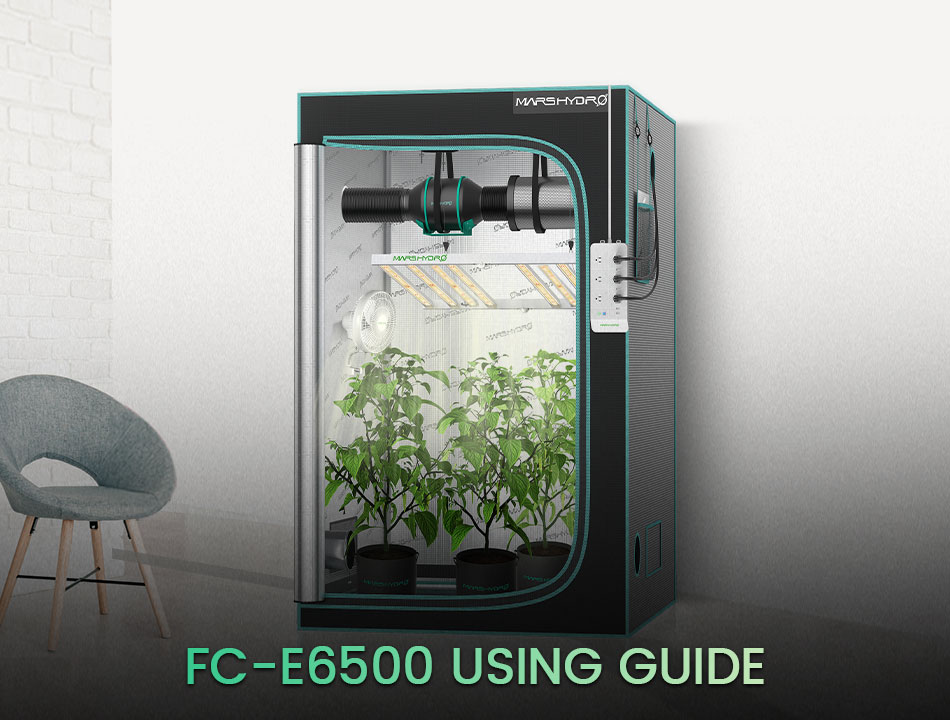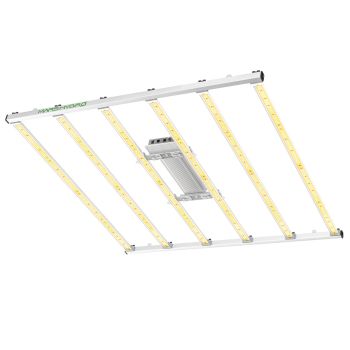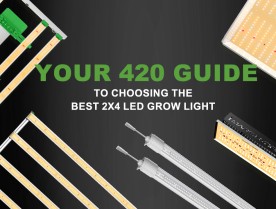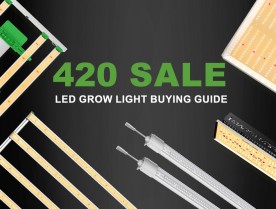
The Mars Hydro FC-E6500 LED Grow Light is a powerful and efficient lighting solution designed for indoor plant cultivation. And it's one of the most popular large led lights on the market. To ensure maximum effectiveness and longevity of the FC-E6500, it is important to follow certain usage guidelines, including proper hanging height, light schedule, coverage area, cooling system maintenance, etc.
In this article, we will provide a comprehensive guide to using the Mars Hydro FC-E6500 LED Grow Light.
Specifications of FC-E6500 LED Grow Light
The Mars Hydro FC-E6500 LED Grow Light is a high-performance lighting solution designed for home and commercial growers. Here are its specifications:
-
Power Consumption: 730 watts
-
HID Equivalent: 1000 watts
-
Spectrum: Full spectrum with enhanced red for flowering
-
PAR Output: 2026 μmol/s
-
PAR Efficacy: 2.8 μmol/j
-
Coverage Area: Maximum coverage of 4' x 4' during flowering, and up to 5' x 5' during vegetative stage. (So we recommend using it in a 4'x4' grow tent or for a 4'x4' area)
-
LED Type: SMD LED chips
-
Dimensions: 25.2 x 22.0 x 2.36 inches
-
Weight: 16.5 lbs
-
Input Voltage: 100-277V@AC
-
Amps: 6.052A@AC120V; 3.003A@AC240V; 2.627A@AC277V
-
BTU: 2489.3
These specifications make the FC-E6500 a powerful and efficient led grow light to support the plant growth to the harvest whether for home growers or for professional cultivators. And it's also equipped with additional useful features to provide a more convenient cultivating experience. Here are its functional features:
-
0-100% dimming capability
-
Removable light bar design
-
Removable power supply
-
Daisy chain dimming function and connectivity

These features provide great flexibility and convenience for growers to customize the light settings to match the different stages of plant growth, as well as save electricity costs throughout the whole growth process.
Light Recipe of FC-E6500 Led Grow Light
The light recipe of the Mars Hydro FC-E6500 LED Grow Light refers to the specific spectral distribution and intensity of light required for optimal photosynthesis and other plant processes, resulting in healthy growth and high yields.
What Should Be Included In A Light Recipe
-
Lighting schedule and duration: the frequency when the light is turned on and off, as well as the length of time of each light cycle, which should be customized to the specific needs of the plants, taking into consideration the different stages of plant growth and the specific light requirements of different plant species.
-
Light density or light level: plant light is measured in micromoles (μmol), the number of photons passing through the target area. Usually, we use PPFD (photosynthetic photon flux density) as a measurement. In addition, the light level also implies how uniform the light is, i.e. whether the light is evenly distributed over all plants, not just those that are centrally located.
-
Light distance or hanging heights: the distance between the light and the plants (canopy), taking into consideration the different stages of plant growth and the specific light requirements of different plant species.
-
Additional spectrum: in addition to the full spectrum lighting provided by the Mars Hydro FC-E6500 LED Grow Light, some plants may require additional spectrums to optimize their growth and yield. For example, some plants may require UV light for enhanced trichome production, while others may require far-red light for improved plant growth and stress response.
The FC-E6500 Light Recipe From Seedling To Flowering

Seedling Stage
-
During the seedling stage, it is recommended to hang the FC-E6500 LED grow light around 16''-18'' above the canopy, with the dimming knob set at 25% - 50%.
-
The lighting schedule should be 18 hours on and 6 hours off.(Please note: although seedlings can withstand 24 hours of light, it will make them stressed)
-
If discoloration, vein growth, or burning occurs, it may indicate that the light is too strong and the dimming knob should be turned down to 25%. If these symptoms persist, check for other potential causes.
-
Clones require more light, so it is recommended to set the dimming knob at around 50%.
-
The FC-E6500 is a full spectrum light with enhanced red light to promote stem growth, so there is no need for additional lighting. However, for better growth, indoor horticulture growers can add additional blue light using a full spectrum grow light that has rich blue wavelengths.
Vegetative Stage
-
For vegetative growth, it is recommended to hang the FC-E6500 LED grow light at 18'' from the canopy in a grow tent and 12'' in a commercial setting, with the dimming level set around 75%-100%. It's important to slowly increase the dimming level so that plants have time to adapt.
-
The lighting schedule should be kept at 18 hours on and 6 hours off, as in the seedling stage.
-
If stretching or burning is observed, lower the light level to 50%. However, keep in mind that as the plants mature during the veg stage, the light level should be increased accordingly. The growth rate during the veg stage is fast, and plants require high and intense light to support their development. If any signs of plant issues arise, it's better to adjust the growing conditions rather than lower the light intensity.
-
The use of IR and Far Red light can help activate the absorption of white light by waking up the plants before the main lights and inducing them to sleep after the main lights. UV light is beneficial during the late veg stage to mimic strong sunlight. SeeHow to use UV & IR to increase your yields and bud potency here.
Flowering Stage
-
During the flowering stage, it's recommended to keep the FC-E6500 LED grow light at a distance of 12''~16'' from the canopy. It's important to note that the closer the light is to the plants, the stronger the intensity of light, but a distance lower than 12'' increases the risk of burns and photobleaching. Therefore, it's important to maintain the recommended distance to ensure the plants receive the right amount of light without any damage.
-
To trigger and ensure proper flowering of the plants, change the lighting schedule to 12 hours of light and 12 hours of darkness. It's crucial to maintain uninterrupted darkness during the dark period, as any interruption can cause the plants to revert to the vegetative state or even pollinate the rest of the crop, which can significantly reduce the overall yield.
-
Photobleaching can be a common issue during the flowering stage, especially when the plants are exposed to high light intensity, increased heat, or nutrient stress. It's crucial to closely monitor the buds during this stage to prevent any damage caused by photobleaching. Click here to see aGuide on Photobleaching.
-
Incorporating UV light during the flowering stage can significantly increase the THC content of the buds. Fortunately, if you have theMars Hydro UR45 LED grow lights, you can easily attach them to the FC-E6500 by clipping the set of light bars onto the grow light to leverage the full power of the FC-E6500 and maximize yields and potency.
-
Utilizing the 660nm wavelength can also contribute to larger buds and higher yields. Fortunately, the FC-E6500 LED grow light includes this spectrum, making it an excellent choice for growers looking to optimize their yields during the flowering stage.
Other Questions You May Want To Ask

How much does Mars Hydro FCE6500 yield?
The Mars Hydro FC-E6500 LED grow light has an average yield of 2.3-2.5 g/w, although the total yield can be influenced by various factors such as techniques, strains, and environmental factors. Currently, the maximum yield reported with the FC-E6500 LED grow light is 2.7 g/w. Keep in mind that while the FC-E6500 provides high-quality lighting, it is not the only factor affecting the yield.
How much does it cost to run a Mars Hydro FC-E6500?
Assume the electricity cost is $0.12 per kilowatt-hour, and assume you're running the growth plan as the following:
-
Germination 3-10 days; 18 hours of light per day
-
Seedling 2-3 weeks; 18 hours of light per day
-
Vegetative 3-16 weeks; 18 hours of light per day
-
Flowering: 8-11 weeks; 12 hours of light per day
That's a total of 1350 hours of light for an entire growth cycle. And the consumption of FC-E6500 is 730 watts. So, to complete an entire growth cycle, it will cost:
730/1000*1350 = 985.5 kwh.
So the cost to run a Mars Hydro FC-E6500 for a complete run is:
985.9*0.12 = 118.26 USD
Conclusion
In conclusion, the Mars Hydro FC-E6500 is an exceptional LED grow light for indoor horticulture growers. Providing it with a good and targeted use guide can maximize its full potential.
Overall, the Mars Hydro FC-E6500 is a solid investment for indoor horticulture growers who want to optimize their yields and grow high-quality plants.
By the way, the FC-E6500 led grow light has a "twin" that is equipped with the latest remote control and programming function, check out the smart FC-E6500 if you're interested.







